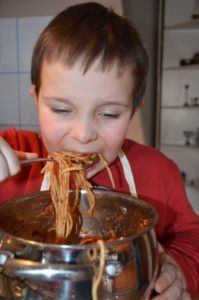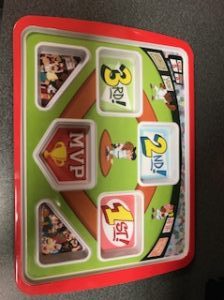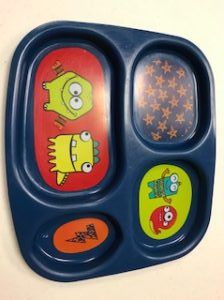Picky Eater
With Thanksgiving quickly approaching, do not let having a picky eater impact your time spent with family and friends. ABC Therapy would like to offer you these helpful feeding strategies to help reduce the stress during your Thanksgiving meals.
- Positioning– Children perform best when their feet are flat on a sturdy surface, eating surface is at waist level, and they’re able to reach all things in front of them.
- Variety– Offer an assortment of foods, both preferred and non-preferred options, but do not force your child to finish full amounts if they are unable.
- Volume- Offer small amounts of each food option so the child does not feel overwhelmed with the quantity on their plate. Children are more likely to try one bite of a new food than a whole helping.
- Choices- Offer numerous choices based on foods provided i.e “Would you prefer the corn or carrots on your plate?”
- Separate and Make it fun– Bring supplies like divided plates, a cupcake baking sheet, fun utensils, or different utensils for each food to help separate food item options.


- Messy Play– If your child is not willing to eat the foods, encourage describing the foods (color, texture, taste, etc.) and allow messy play so they can explore and interact with the options on their own terms. An example of messy play could be utilizing various cookie cutters to make playful shapes.
- Model– Demonstrate to your child what your expectations are with each food and how they should interact with it.
- Provide Praise but not Reward– Children feel accomplished when given praise like “I like how you took a bite out of ___”, “I see that you are trying hard to try ___”, “Good job touching ___”. However, providing a treat after eating a non-preferred food is not the best option for supporting carry over and independence in the skill.
- “All Done” bowl – Provide a safe place for the child to eliminate the foods from plate when they are finished to reduce overall anxiety.
- Back-up Plan– Pack the child’s f
 avorite foods in the case they are unwilling or unable to tolerate the foods provided.
avorite foods in the case they are unwilling or unable to tolerate the foods provided.
Hopefully these food-related strategies will help reduce stress for the whole family during the holiday season! Enjoy time with your family and don’t let picky eating impact the quality of time with loved ones. For more information pertaining to picky eating or other therapy-related resources, please visit https://www.abcpediatrictherapy.com/.
Happy Thanksgiving!
Read MoreDid you know by 3 your child’s diet should typically consist of a variety foods with various textures, sights, temperatures, colors and consistencies? If your child is not eating a variety of fruits, vegetables, meats, and mixed foods (such as mac and cheese or spaghetti), then your child may be a picky eater.
Before addressing feeding, make sure you child’s sensory needs are being meet. Sometimes addressing sensory concerns, such as deficits in proprioceptive input (knowing where your body is in space through heavy work or deep pressure), vestibular input (movements such as swinging), and or tactile input (how your body reacts to touch) can be enough input to help your child try new foods.
Having your child jump on the trampoline or in place, wheelbarrow walk or any animal walk to the dinner table, and or swing prior to eating could be good activities to complete before meal time. Your child could also benefit from the brushing protocol to help with sensory input (contact an occupational therapist at ABC Pediatric Therapy for more information on this protocol). Also, make sure child is okay with getting messy. If s/he is not, it will be beneficial to address this first as well.
Using shaving cream is one of the easiest messy play activities. At first, make sure your child tolerates being in the same area as the shaving room. Once s/he tolerates being near the shaving cream, have your child begin interacting with it. Put cars, planes, or boats in it and have the child push these around without touching the shaving cream. Slowly begin introducing shaving cream onto the cars and see if your child will continue to touch the cars. Once they do, see if your child will imitate you drawing roads for these cars in the shaving cream. After your child tolerates interacting appropriately with the shaving cream your child is ready to begin trying new foods.
Dr. Kay Toomey developed a feeding hierarchy that has been proven to have great success is regards to sensory picky eaters. Following along the same lines as shaving cream play, Dr. Toomey wants children to be able to tolerate and interact with new foods before actually eating them. If they are not able to tolerate being at the table with the food, then they are not going to be able to interact with it.
To assist with interacting with food, have your child prepare food and use utensils or the container to stir or pour foods/drinks. If your child is having difficulty with using utensils and self-feeding skills, please contact an occupational therapist for additional assistance.
Once your child interacts with foods, the next step on the hierarchy is to smell the foods; have your child lean down or pick it up to smell the food. The next big step is touching foods; go from touching it to his/her fingers to whole hand to chin/nose to lips to teeth to tip of tongue to full tongue to licking it. At this point, reward your child with a preferred food after 1-3 consecutive touches or licks of a non-preferred food. After your child is licking new foods, the next step is to begin tasting them. Initially have him/her take a small bite and designate a spit out jar. Once s/he is able to do this, see if your child can hold the food in his/her mouth for a certain amount of time or even chewing a certain amount of times before spitting out. The next goal would be to chew and swallow with a drink and then independently. Also, at this point, begin rewarding your child with a preferred food after so many bites of a non-preferred food. For example, have your child take 2 small bites of a green bean before being rewarded a preferred gold fish and then repeat this until you are satisfied with how many bites of a non preferred food your child is eating in one sitting.
If your child is not making the progress you want, your child may have oral motor deficits. For example, if your child is only eating softer, blander foods, they may have decreased strength. They may also have an immature chew which could make feeding difficult. An occupational therapist would also be able to assess this. A therapist will also be able to determine if your child is having sensitivities to the temperature, texture, flavor, sight, or smell of certain foods which could be inhibiting his/her success.
Please contact ABC Pediatric Therapy for more ideas geared towards your specific needs and if you have any additional questions. Visit our website at www.abcpediatrictherapy.com to find the location nearest you.
Read MoreIn order to learn about the world around them, children need to experience a variety of environments and situations. They need to be able to move, explore, climb, play, learn, and rest. In order to do all of these things as efficiently as possible, children need a varied diet full of nutrients. Without these critical nutrients, children may not have the energy, attention, or cognitive functioning to absorb all of the information around them.
Eating balanced and nutritious meals is crucial for a child’s overall health and development. As we grow, our bodies use the nutrients we get from food to help us function and perform daily tasks. According to the article “The Importance of Healthy Eating in Children” posted on www.livestrong.com, children need “plenty of water and enough protein for growth and cellular repair. Children need adequate carbohydrates for their high energy levels and just enough fat to provide essential fatty acids for cell growth. Finally, children’s diets require enough iron, calcium and vitamin D to strengthen blood and bones as well as zinc and magnesium to support the immune system. All of these nutritional requirements can be met through a diet high in fruits, vegetables, grains and meats.”
If you are having trouble getting your child to eat a variety of foods, here are some tips and strategies to try at home:
• Try new foods that are similar to those your child already enjoys. For example, if your child likes French fries, try introducing a few sweet potato fries on their plate. If your child likes pizza, try adding chopped up vegetables on the pizza. If your child likes chips, try pretzels or veggie straws.
• Use what your child likes to your advantage. If your child likes cheese, try broccoli and cheddar soup or cooked vegetables with cheese sauce. If your child likes macaroni and cheese, try using vegetable pasta instead of regular pasta.
• Involve your children in the food-making process. Take them grocery shopping, have them help mix ingredients together, or have them taste-test along the way. Knowing that they were part of making the food may encourage kids to try the finished product.
 • Consider planting fruits and vegetables outside. This can be a great learning experience for children on where food comes from, as well as an opportunity to try something they actually grew.
• Consider planting fruits and vegetables outside. This can be a great learning experience for children on where food comes from, as well as an opportunity to try something they actually grew.
• Take advantage of dips. Find a dip that your child enjoys, such as ranch, spinach and artichoke dip, or hummus. Use that as a tool to encourage trying new foods to dip.
• Make mealtimes and food prep fun and be creative. Use cookie cutters to cut food into different shapes, make silly meals from your children’s favorite TV shows, or come up with silly names for foods.
• Give your child choices. Children like to be in control and letting them pick from a few choices of what they will have on their plates is a good way to increase cooperation.
• Limit grazing. This will help your child establish an internal system that promotes eating when they are hungry rather than snacking throughout the day, which can increase their willingness to try new foods.
• Find foods that are your child’s favorite color, or try to eat all the colors of the rainbow. Make a game out of it and see who can eat the whole rainbow first
For more information on typical oral motor and feeding development in children, visit www.abcpediatrictherapy.com and review the developmental checklists. For guidelines regarding suggested dietary needs for children of different ages, review https://www.mayoclinic.org/healthy-lifestyle/childrens-health/in-depth/nutrition-for-kids/art-20049335. If you have additional concerns about your child’s diet and nutrition, speak to your pediatrician.
Try the above tips and if your child does not begin eating a variety of foods, reach out to us! We, at ABC Pediatric Therapy Network, can help!
Read MoreMealtimes and food are such an important part of our society and culture. We eat together as families, we go out to restaurants with friends, and we bring appetizers and snacks to gatherings for all to enjoy. A significant amount of our social lives and family routines revolves in part around food. For families with children who are picky eaters, these enjoyable and social experiences can become stressful and conflict-causing situations.
Picky eating can lead to serious health concerns and have long-term effects on the well-being of the child. Picky eaters often have a very limited diet – eating only a handful of foods willingly. Because of this, picky eaters are not typically getting all their nutritional needs each day. This can lead to deficiencies, such as iron, calcium, zinc, and vitamin deficiencies for example, which can lead to other illnesses and complications later in life. These deficiencies can also have the following negative effects:
· decrease your child’s attention and energy levels, which can prevent them from being able to explore their environment and learn new information as efficiently
· decrease cognitive functioning
· weaken their immune system, making it harder to fight off illnesses and diseases
· increased risk for weight problems (under or overweight)
· dental problems if preferred foods are limited to snack items/sweets
Not only does picky eating affect a child’s health and well-being, it also negatively impacts the social well-being of the child and the family as a whole. As a parent, one of your primary roles is to provide for your child, and not being able to fulfill that role can be stressful, isolating, and extremely frustrating. Increased stress can lead to conflict in relationships, including the parent-child relationship, as well as the relationship of the parents. Picky eating can lead to refusal of foods and negative behaviors from the child (screaming, crying, etc.). These behaviors can all increase a parent’s stress and frustration, as well as lead to negative feelings and attitudes towards mealtimes and family routines. For the child, not being able to participate in snack or mealtimes at school or daycare can negatively impact his/her ability to interact with peers and learn social norms.
For more information on typical oral motor and feeding development in children, visit abcpediatrictherapy.com and review the developmental checklists. If you have concerns regarding picky eating, here are a few tips to try at home:
· Create a mealtime routine and try your best to stick to it. Children thrive with routines. Having a routine helps them understand what is happening right now and what to expect next. This can help lessen anxiety, especially when introducing and trying unfamiliar foods (which can be an anxiety-causing situation for many children). Try to eat meals around the same time each day and in the same place, such as at the table.
· Give your child choices. Children like to be in control and letting them pick from a few choices of what they will have on their plates is a good way to increase cooperation.
· Limit grazing. This will help your child establish an internal system that promotes eating when they are hungry rather than snacking throughout the day.
· When introducing new foods on the child’s plate, always offer foods that the child likes and will eat, as well.
· Try to boost the nutritional value of the foods in the child’s current diet. For example, if the child likes smoothies, mix in some yogurt for added protein or some spinach for added vitamins and minerals. Consider vitamins and other supplements, as well.
· Provide lots of positive feedback, even for small victories. If a child allows an undesired food to stay on his/her plate the whole meal instead of throwing it on the floor, tell the child how proud of them you are. Use sticker charts, rewards and incentives, etc. to increase cooperation.
If you try these suggestions and are still struggling with success at mealtimes, please reach out to us at ABC Pediatric Therapy Network. We can help! Family time should be full of wonderful memories and not stressful power struggles.,
Read More Skip to content
Skip to content



 avorite foods in the case they are unwilling or unable to tolerate the foods provided.
avorite foods in the case they are unwilling or unable to tolerate the foods provided.

